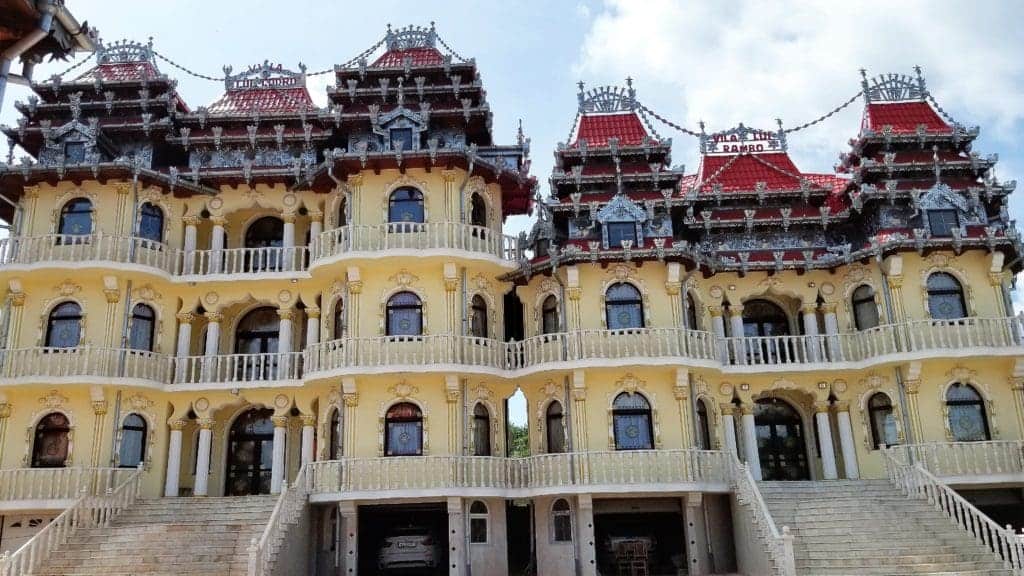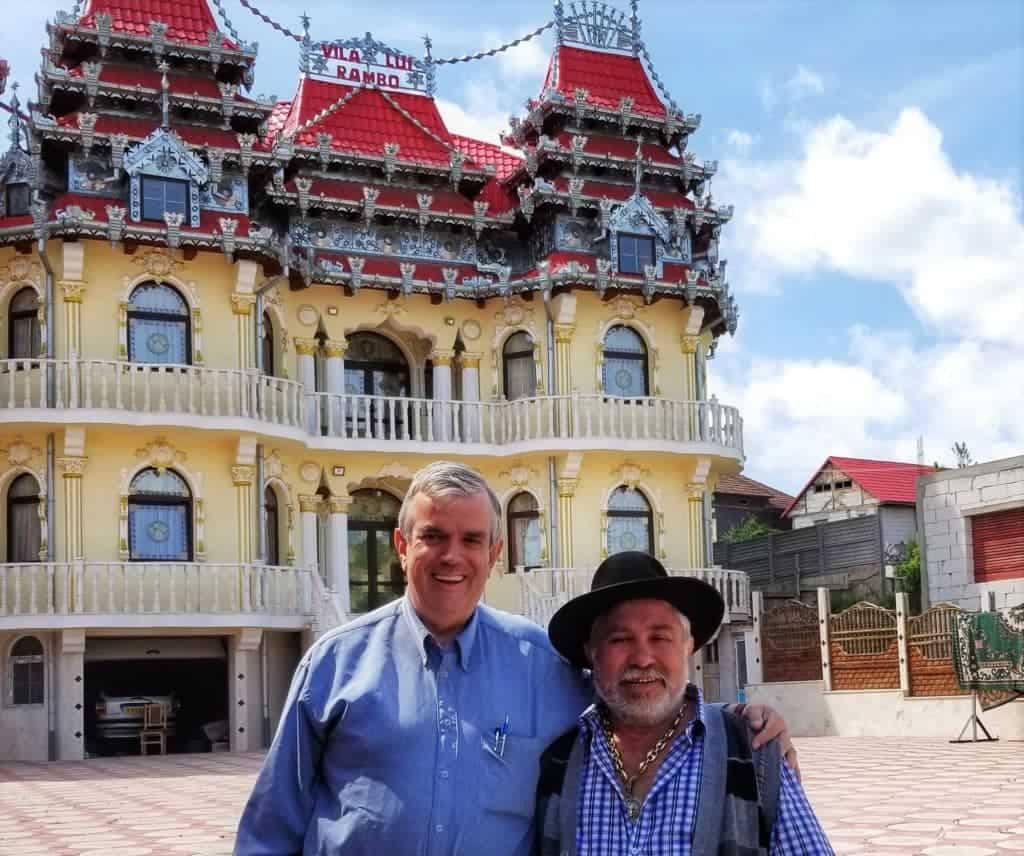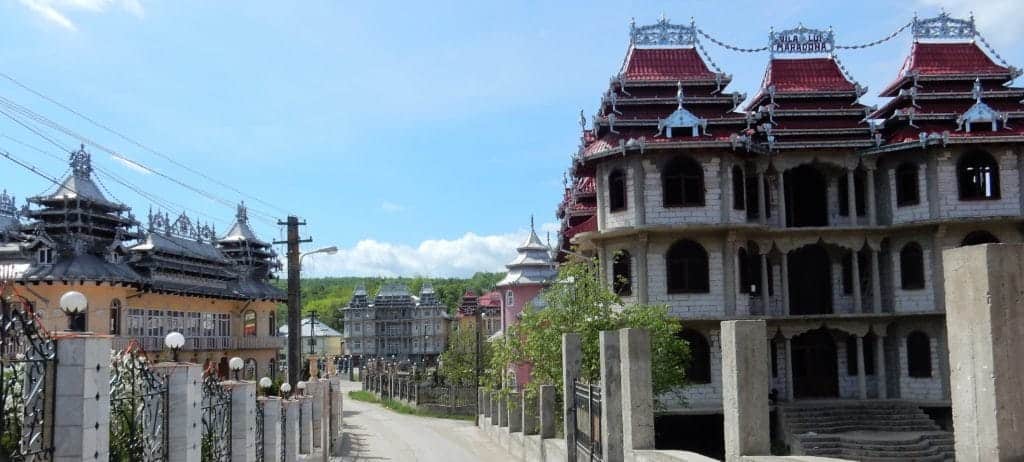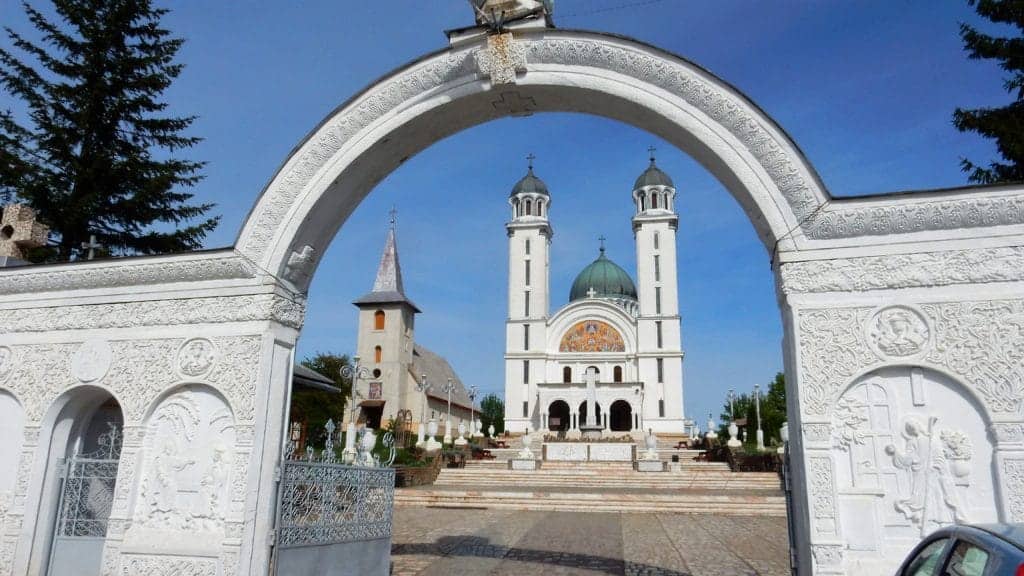WOW What a day!

We had a busier day than normal planned, with a lot of driving around in the car to different sites and villages. In the middle we had planned to do a 20 km ride around ½ of a major tourist area at Lake Cincis. There is a road only on one side of the lake, which meant that we had to ride on the same road in two directions. On the way to Lake Cincis we had been told to drive through the village of Hațeg. We were told that this village had more of the huge Gypsy mansions than any other area in Romania, even more than the one we saw last week. It was mind boggling to see all these huge mansions, many jammed up against each other. As we drove slowly around a gentleman called out to us from his car to say hello and mention Canada. Our car has a Canadian sticker (mandatory in Europe) and a small Canadian flag on the front bumper. As we drove on some through other parts of the village, two younger boys wanted us to stop and talk about Canada. As we were talking to them the first gentleman drove by again. It was obvious that we were driving around gawking at the homes and he asked us if we wanted to see his house. He said it was one of the mansions on the corner. I felt a little funny, but we said yes. We followed him to a plot of land with 3 mansions on it, two of them so close that they shared balconies although the buildings were actually separate. See the two sons homes in the picture above. I think I mentioned in a previous article, that Mike and I were wondering how many people lived in one of these mansions. We had heard rumours that there were many families in a single mansion. Given their size, this made sense to us. As is often the case, rumours have a way of getting things quite wrong. Puhu, the man that invited us for a drink, is a gypsy. He has three sons and each one owns one of the three mansions. One son has two children and another three children which means that each mansion housed four or five people in total, not 20! Puhu lived with his youngest son. Family is all important in the gypsy culture. We sat in a large courtyard that was shared by all three mansions and had coffee with whipped cream. The courtyard is often used to host large family gatherings. Puhu’s wife wanted to cook us true Romanian soup for lunch, but we turned it down. We spent a fascinating hour with them. Their sons were painters and work in England. We don’t know the details about how much time they spend in which country. We had previously been told that people in Transylvania were over the top friendly, much like our great Newfoundlanders. It just might be true.

For a little while we talked about the economy and the past, in terms of Nicolae Ceaușescu. As most of you are probably aware, Nicolae Ceaușescu’s regime was considered one of the most repressive in Eastern Europe. We were always told that he completely controlled the media and that his methods were among the harshest, most restrictive and brutal in the world. Ceaușescu bankrupted Romania, largely with his grandiose plans and infrastructure spending. A lot of other Eastern European rebellions were occurring at the same time (1989) including the fall of the Berlin wall and the Velvet Revolution in Czechoslovakia. The only one that was won through violence was in Romania. Comments that we received both from Puhu and other people recently said that things weren’t necessarily tremendously better now. I have read that Romania is trying to crack down on its corruption in government. One person said that corruption would never have occurred to a large degree at the local level as Ceaușescu would have dealt extremely harshly with the offenders. Someone else said that although they disliked Ceaușescu, at their age of 80, they would have been better off under communism than they are today. Another person blamed countries like Canada, for making huge profits from Romania’s natural resources. Mike and I always enjoy learning about the many different points of view when we travel.

After leaving the Hațeg, we carried on to Lake Cincis and unpacked our bikes for a nice ride. The lake is manmade. In 1964 a large dam was built, and 3 villages and churches were flooded to provide water for the Hunedoara Iron and Steel plant. At low tide you can still see the ruins of one of the churches in the water. The main town of Cincis was moved to the top of a nearby hill. The lake has become a prime vacation area. We were told that it was lovely, and the information was correct. We biked about 10 km from one end of the lake to the other and another 10 back, having our mandatory cappuccino stop enroute. The road was very hilly, with lots of blind curves and was quite narrow. When there was no traffic it was lovely. When there was traffic from both directions it was a little disconcerting as there was no room to get off the road. Once a large truck came from behind me and started passing me at the same time a van came around the curve from the other direction. At this point the truck had not completely passed me and couldn’t swerve back into his own lane. There was a large squealing of brakes as both vehicles and me on my bike all came to a full stop. The two trucks ended up facing each other and I remained safe but somewhat shaky, at the edge of the pavement. We had one other concern and that was the hills. This road was the hilliest (is that a word?) that we had tried our new electric bikes on. Biking to the end of the lake was overall downhill. Even then Mike thought that some of the hills were the limit that his bike could do. We were worried that our bikes couldn’t easily handle the hills coming back and also that the batteries might die in that terrain. As it turned out everything worked perfectly. My bike handled everything like a dream, I think my motor is a little more powerful than Mikes. Mike had to work hard with one hill but between his pedalling and the motor he made it to the top successfully. It was a beautiful day, beautiful scenery and we had a good time.
Our next stop was to have a look at another Orthodox church in the mountains. We were told that it was one of the oldest churches in Transylvania. When we got there, we discovered that there had been a very old wooden church that was torn down in the 1800s. In 1770 a new stone church was built, and it is still on the property. In 1939 a new, modern Orthodox church was started. Construction stopped from 1945 – 1955 due to communist persecution. It took until 1973 to be completed. We met a priest in the courtyard who was just leaving. He stopped to talk with his. While his English wasn’t perfect, it was certainly good enough to educate us. This priest was marvellous. He took us inside and throughout portions of an Orthodox church that we hadn’t been able to see before. He explained all sorts of things starting with the basic fact that this branch of the Orthodox church is Romanian Orthodox, not Russian or Greek Orthodox. They have their own Patriarch and some differences in the “rules” to those of the other branches. He told us that he was married with three children and that marriage was quite acceptable within the Romanian Orthodox religion. According to the internet, in general in Orthodox churches: “Priests are permitted to be married but may not marry after ordination. Bishops must always be celibate. ” I think that the Romanian branch is more liberal.

Last year we discovered that Lutheranism was everywhere in Northern Europe. In Romania almost 90% of the population is Orthodox. About 200 million people in the world follow the Orthodox tradition. Loaves of bread are used during the Orthodox services; Mike and I had seen this before. Apparently, the bread is imprinted with a seal, blessed, and cut by the priest very precisely to represent the body of Christ. The internet says that: “If someone hands you a piece of blessed bread it is a sign of fellowship.”. Mike and I were given two loaves by the priest. He explained that these loaves of bread had not been consecrated and that we could therefore treat them as we would any other loafs of bread.
The priest talked quite a bit about the symbolism of everything that we saw in the church. A few items stuck in my mind. He said that in the Orthodox religion people are connected through their eyes. All the major pictures in the church, maybe all the pictures I am not sure, had eyes that followed you as you moved around. They were very well done although I always find those pictures kind of spooky. My grandmother had one in her living room. At St. Peter’s in Rome I remember one picture where the table points towards you, whichever side of the picture you stand on. Another piece of symbolism that the priest mentioned was the importance of the number 8 in his religion. Apparently 8 means everlasting or infinity. As a math major that is easy to understand, since the symbol for infinity looks like an 8 on its side. We spent a fascinating hour with this priest and thanked him for being generous with his time.

Thanks to the gypsies and the priest it was much later than we had intended at this point and we decided to give up on the other places we were going to visit and go back home. When we got there, we found that our very quiet campground was just bustling with people. Two caravans, one motorhome and at least one van had all come in together. They all had a professional paint job that said “Bristanbul: 21 countries in 21 days”. They were from Bristol, England. It turns out that all the campers where made by a company called Bailey of Bristol. For the last few years the company has sent their campers on some endurance drives for advertising and promotion purposes. Last year they drove to north of the arctic circle. This year they wanted to test the durability and endurance of their caravans and motorhomes in real-life situations. To do this they were going to drive 5,000 miles through countries that aren’t often high on the tourism route. They were going from Bristol to Istanbul and back through 21 different countries, many in Eastern Europe. We met up with them in Romania. They had support vehicles, drivers, engineers and mechanics to fix any problems with the campers, photographers, videographers and very importantly, at least two chefs that we met. One had come in second in the Master Chef TV series. Mike enjoyed a lovely Thai curry cooked for the group which I declined. When we saw them, their group of 17 people traveling together was down to 14 and it was the last week of the trip. They didn’t have enough sleeping quarters in the three campers for everyone, so they tried to book campgrounds where they could also get beds or, in our case, pitch some tents. They were a very nice friendly bunch of people who were extremely impressed with our North American motorhome and slideouts.
From Gypsies to priests to an unusual British crew, what a great day.

Leave a Reply